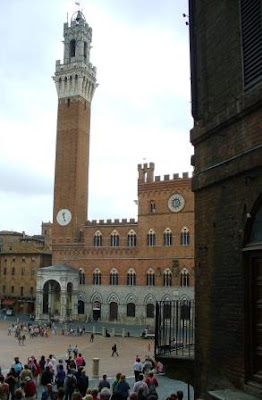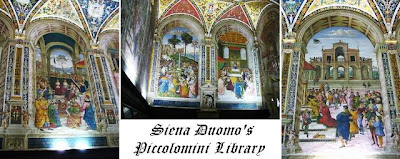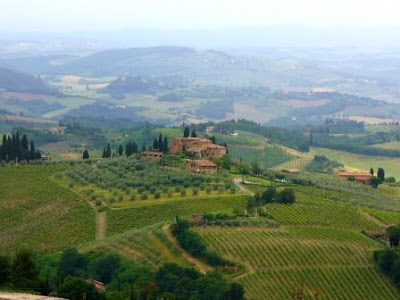 Italy is a country in a rush to nowhere. A second after a traffic light has turned green drivers start pushing their horns for the cars and scooters in front of them to go-go-go. Nevertheless, taxi drivers, although most of them drive aggressive, they are not as aggressive as taxi drivers in New York or as death-defying as drivers in Monterrey. Mexico.
Italy is a country in a rush to nowhere. A second after a traffic light has turned green drivers start pushing their horns for the cars and scooters in front of them to go-go-go. Nevertheless, taxi drivers, although most of them drive aggressive, they are not as aggressive as taxi drivers in New York or as death-defying as drivers in Monterrey. Mexico. This afternoon, on our way from the station to our apartment, a woman coming towards us put her shoulder into my son, sending him two steps back and nearly onto the road. I have seen similar gestures in Rome and Florence. Maybe it is an anti-tourist thing by some Italians. I was walking three steps behind my son and when I saw it happened I felt like dropping my shoulder and return the courtesy, but I realized it would have send her scattered-like-the-wild-wind into a massive shop window. Her face showed the determination to not budge for anyone, so I refrained, gave her the benefit of the doubt of a bad day at the office or something like that.
Our trip today, a prepaid bus tour with guide to Siena, took place in pouring rain and a sudden drop in temperature to about 20 degrees Celsius. When we left Florence it was a beautiful day, hardly a cloud in the sky. About 30 minutes after we arrived in Siena, which is about a 45 minutes drive from Florence by bus, it started to rain. First it was just a soft drizzle, but later it turned into a solid down pour and water rushing down the steep narrow street of Siena like a whitewater rapid. We were not dressed for the occasion, nor were several of the other people on the tour with us, and we had to quickly scramble to buy sweaters against the cold. Luckily we took umbrellas with us.
 On our way to Siena we passed the medieval Tuscany town of Monteriggioni, still surrounded by its virtually intact curtain walls and fourteen towers.
On our way to Siena we passed the medieval Tuscany town of Monteriggioni, still surrounded by its virtually intact curtain walls and fourteen towers.Siena’s main square, which is really fan-shaped, the Piazza del Campo, location of the famous biannual horse race, (some call it a folk festival) Il Palio, was spectacular. (For a more detailed description of what happens on race day click here.) The piazza is dominated by the Palazzo Pubblico and the Torre del Mangia (The clock tower). Interesting enough, the façade is curved inward (concave), following the curve of the piazza. The bell tower was the tallest structure in Italy upon its completion in 1344.
 Siena's Palazzo Pubblico and the Torre del Mangia (the clock tower)
Siena's Palazzo Pubblico and the Torre del Mangia (the clock tower)  Siena's Palazzo Pubblico on the Piazza del Campo.
Siena's Palazzo Pubblico on the Piazza del Campo. From the Piazza it is a short walk to the Siena Duomo. The cathedral, completed in 1263, was very impressive with its black, white and pink marble, but it was very dark on the inside. The cathedral floor is suppose to be one of the most ornate floors of all Italy’s churches, but most of it was covered to protect the delicate mosaics from more wear and tear. We were fortunate to see one of the oldest floor panels, the She-wolf of Siena. Although the cathedral contains many artistic treasures from Michelangelo, Donatello, Bernini, and others, it was the Piccolomini Library that I found most impressive. The painted frescoes tell the story of Siena’s favorite son, Cardinal Enea Piccolomini who would later become Pope Pius II from 1458 – 1464.
 Siena's Duomo facade.
Siena's Duomo facade.  Inside the Siena Duomo. Strickingly, and different than any other cathedral we saw, the black and white horisontal marble effect. This picture was "doctored" to lighten it a bit. It was quite dark inside the Duomo.
Inside the Siena Duomo. Strickingly, and different than any other cathedral we saw, the black and white horisontal marble effect. This picture was "doctored" to lighten it a bit. It was quite dark inside the Duomo.Unfortunately we never had a lot of time to explore the medieval city center because of the rain. We had lunch at a grotto-like ristorante, called Cannonero, where the bread was rock-hard, the zuppa fantastic, the spaghetti tasteless, but the Chianti Classico marvelous. We shared a table with two French couples and one of the men degraded the lovely wine by drinking it with water. Luckily his wife had more sense and enjoyed it as is.
The highlight of the day was a stop at San Gimignano on our way back to Florence. The historic center of the town is a UNESCO World Heritage site. It served as an important relay point for travellers to or from Rome on the Via Francigena. At one stage the town had 72 tower-houses, built by families to show their power and wealth, but only 14 survive.
The highlight of the day was a stop at San Gimignano on our way back to Florence. The historic center of the town is a UNESCO World Heritage site. It served as an important relay point for travellers to or from Rome on the Via Francigena. At one stage the town had 72 tower-houses, built by families to show their power and wealth, but only 14 survive.
 San Gimignano's main street. In the back is the arched entrance to the medieval city. There are no sidewalks in the town. The few cars and pedestrians share the modern paved roads. San Gimignano is probably the most famous small in Italy and it is obvious that the town council knows that it has a "tourist goldmine" as its hands, hence the fact that the town is in an excellent maintained state. It has many good restaurants, art galleries and shops that sells locally produced artifacts.
San Gimignano's main street. In the back is the arched entrance to the medieval city. There are no sidewalks in the town. The few cars and pedestrians share the modern paved roads. San Gimignano is probably the most famous small in Italy and it is obvious that the town council knows that it has a "tourist goldmine" as its hands, hence the fact that the town is in an excellent maintained state. It has many good restaurants, art galleries and shops that sells locally produced artifacts.We only had an hour to explore the town and rain threatened all the time. Walking around in this 12th century medieval town with its many towers was beyond words. The narrow streets, barely 2 meters wide at some places, and some pitch dark, grotto-like, gives one some idea what life was like in the middle ages. The small town with a single main road between two squares was one non-stop tourist trap, shop after shop, selling “local craftwork”, probably made somewhere else in Italy. I ventured of the main road to take some pictures of other parts of the town, eventually ending up at an old castle, while Monica and Lamar toured the main road. In the end I ran out of time and luck. I had to run back to the bus in pouring rain, but I made it, just in time before the bus departed. But San Gimignano was well worth it, a marvelous town, just wished we had more time.
 Three of the remaining 14 towers seen from the hilltop castle.
Three of the remaining 14 towers seen from the hilltop castle.Upon our return to Florence I bought some pasta, meat and ingredients to make Penne al Ragu-Bolognaise. We are still to eat a good meal in Italy and my family agrees that I make a good Ragu, better than what we had in Italy so far. Apart from the pizza the first night in Naples, which was the best pizza I had in my life, the food has been rather average to poor.
 Siena Duomo floor panel. This panel, the She-Wolf of Siena, was one of only a very few that were not covered for protection. This panel was create around 1372. Imagine how many few have walked across this mosaic the past 635 years. No wonder they cover them protection.
Siena Duomo floor panel. This panel, the She-Wolf of Siena, was one of only a very few that were not covered for protection. This panel was create around 1372. Imagine how many few have walked across this mosaic the past 635 years. No wonder they cover them protection. Unlike other churches where you have to look up and wonder at the details of the rose window, the Sienese removed the original rose window and it is now displayed in the Duomo's choir. This 6 x 6 meter window tells the story of the Last Supper.
Unlike other churches where you have to look up and wonder at the details of the rose window, the Sienese removed the original rose window and it is now displayed in the Duomo's choir. This 6 x 6 meter window tells the story of the Last Supper. The vivid colors of these frescoes, painted between 1502 and 1507 by Pinturicchio and his assistants, in the Piccolomini Library makes them a jewel on the eye.
The vivid colors of these frescoes, painted between 1502 and 1507 by Pinturicchio and his assistants, in the Piccolomini Library makes them a jewel on the eye. Tuscan countryside: A farm under grapes and olive groves.
Tuscan countryside: A farm under grapes and olive groves.  Monica in San Gimignano.
Monica in San Gimignano. Andre & Lamar in San Gimignano in our hastily purchased "Italia" sweaters.
Andre & Lamar in San Gimignano in our hastily purchased "Italia" sweaters. 
No comments:
Post a Comment